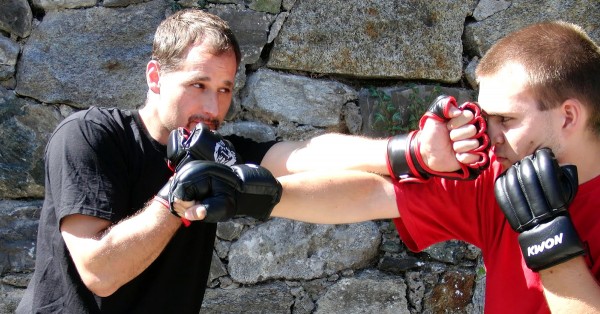Panantukan (also Suntukan) is the Filipino "Dirty Boxing". No tournament sports, but a self-defense system for the street. Many techniques aim to confuse or unbalance the opponent.
The attacker is way too sure of himself. He swings a brutal haymaker to smash his opponent to the ground. But out of the sudden, quick blows and strikes hit him like a volley of a machine gun. They hit head, arms and upper body - seemingly at the same time. Even before he can even realize what is going on, a quick but firm grip makes him lose his balance and he goes down. This effect, the overpowering, is part of the tactical concept in Panantukan. The ingenious fist fighting system was made popular by Dan Inosanto, a close friend and teacher of Bruce Lee. It originated in the Philippines, where various influences met each other.
Panantukan has influenced professional boxing
Ceferino Garcia was one of the most successful professional boxers of the Philippines. In 1939 he defeated the American Fred Apostoli in New York and won the world title in the middleweight division. In the ring Garcia abided to the rules of tournament sport. But the fighter also mastered the rougher fighting techniques of his homeland. Before he was spotted by a boxing promoter, Garcia had worked on a sugar plantation. There he had to harvest sugar cane with a bolo, the Filipino machete. Years later Garcia surprised his opponents with a technique unknown in the West: his signature "Bolo Punch" was a combination of hook and uppercut. The movement is derived from the swinging technique with which field workers use their bolos.
Western boxing has always been popular in the Philippines. Panantukan looks quite similar at first glance. But it contains many techniques that are strictly prohibited in tournament sports. Strikes to the temples or groin for example, or backhand and elbow strikes. Fighters rarely face each other like in duels. Rather, they move around very dynamically and use blind spots of the opponent for surprising attacks. Similar to knife fighting in Eskrima, Arnis or Kali, the attacker virtually orbits his target to find a gap in the defense. The defender starts his counterattack immediately while defending. Through series of quick punches and grips he puzzles the attacker to throw him off-script.
Painful counter technique: gunting
A specialty of the Filipino Martial Arts is a counter tactic called "Gunting". The defender starts to counter during the ongoing attack and strikes the attacker's limbs. For example, he will hit the biceps of the attacking arm with his fist or elbow. Not only is the attack blocked effectively. The blow paralyzes the muscle. If the arm has been hit precisely, it can no longer be used in combat. Since this painful form of resistance is unusual even for experienced boxers or street thugs, it distracts the attacker psychologically. The gunting is followed by other techniques with which the defender brings the situation finally under his control.
In Panantukan, blows are often made from unexpected positions and angles, such as under the opponent's arm. The trained eye can recognize similarities to the Indonesian Silat. In contrast to classic boxing, punches are combined with grips. This means, for example, that the arm of the attacker can be controlled, similar to Arnis, Escrima or Kali. A pull or twist can quickly take the opponent to the ground. In training, the student learns the necessary technique and a certain feeling for the body mechanics through drills, flowing sequences of several techniques. This way, they learn the ability to combine different movements creatively and dynamically.
There is not just one Panantukan, but many.
The newcomer can chose between various schools. Some emphasize the applicability on the street and are quite similar to modern close combat systems such as Israeli Krav Maga. For others, the most important component is the transferability of stick-and-knife movements typical for Filipino Martial Arts. You learn a movement pattern that is equally applicable with or without a weapon. Furthermore, other schools are focusing on the proximity to Philippine grappling, which is called Dumog, by training mainly grips and control techniques. Panantukan is not a fixed system, but continues to evolve. Anyone starting training today may soon be able to contribute their own ideas to this ongoing process.
Did you like this article? Follow Fightingsticks on Facebook and Pinterest.
Photo: © Roninz Kampfkunstschule

